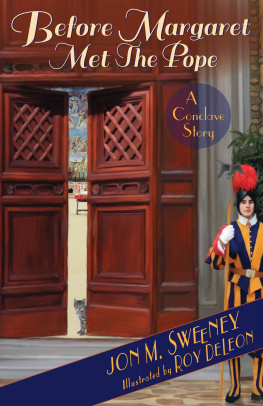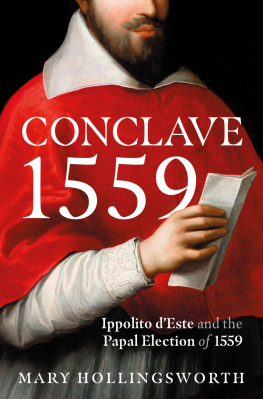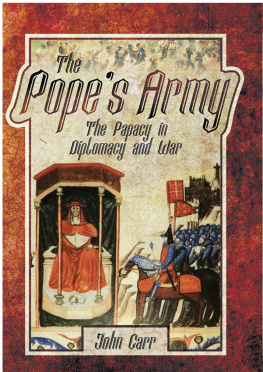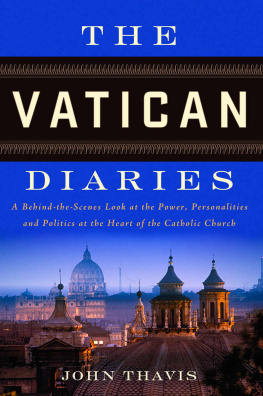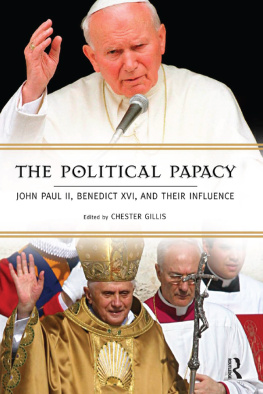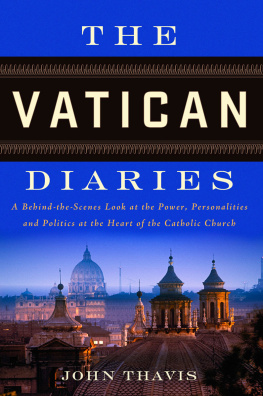Preface
F or about eight centuries, the Roman Catholic Church has used a strange process called a conclave to select its pope. The term comes from two Latin words meaning with a key and refers to the practice of putting electors in a locked room and refusing to let them come out until they choose someone. A conclave is an event surrounded by legend, one that uniquely blends theater with mystery, politics with prayer. Oddly enough, the best vantage point to see just how strong a grip the conclave has on the popular religious imagination may not be Rome, with Saint Peter's Square and the Sistine Chapel, but a stretch of rural Highway 24 in northeastern Kansas. Following the road about twelve miles to the north and west of the state capital of Topeka leads one to the small town of Delia, population 172, and a nondescript thrift shop called the Question Mark.
Few realize that the most recent conclave on record (and there may be others we don't know about) happened not on October 16, 1978, with the election of the archbishop of Krakow, Karol Wojtyla, as John Paul II. Instead it took place in Delia on July 16, 1990, in a tiny chapel inside the Question Mark, space for which had been created by shoving aside the shop's soda machine and laying some shag carpet. Six ultra-right-wing Catholics gathered to elect the person they regard as the first valid pope since 1958, when Pius XII died. The pope who followed, John XXIII, launched an era of modernization that some traditionalists have never accepted, including the electors in Delia that hot Kansas summer day. They included Clara "Tickie" Bawden, her husband, Kenneth (owner and operator of the Question Mark), a couple from Michigan, a Colorado spiritualist, and the Bawdens' son, David. All are former members of the Society of Saint Pius X, a movement launched by a right-wing French archbishop who disapproved of the liberalizing trends in the Catholic Church after the Second Vatican Council (1962-65). The six who assembled in the Question Mark not only had rejected the mainstream of the Roman Catholic Church but had also abandoned the Pius X movement, alleging that it too had been corrupted by modern secular civilization. (The fact that the society had kicked David out of one of its seminaries was also acknowledged to be a factor. David had later signed up with another traditionalist Catholic group, in Saint Marys, Kansas, only to grow disenchanted there too and eventually cooperate in an expose published in the Kansas City Star.)
As conscientious Catholics, the six electors followed the outlines of the church's process for selecting a pope. They secluded themselves in a chapel, prayed for the guidance of the Holy Spirit, and proceeded to election by secret ballot. They swore before God to discharge their duties faithfully and to elect the person they considered best suited to lead the Roman Catholic Church. In short, they held a conclave. Some incidentals proved impossible to reproduce; no white smoke, for example, appeared above the roof of the Question Mark. For all that, the essentials of the conclave were there. It was a watershed day for the Bawdens, since the new pontiff who emerged from the one-ballot conclave was their son, David. In keeping with a papal custom that dates from the sixth century, he took a new name: Pope Michael I, after Saint Michael the archangel.
Little else changed, however, for the would-be pope. He still lives at home, still takes out the garbage at night. He reigns from his version of a papal thronean old armchair with orange cushions that sits on the porch of the family house overlooking Highway 24. He insists that his obscurity leaves him untroubled. He takes comfort from Saint Athanasius, whose opposition to the Arian heresy once made him, too, a minority inside the church. Today it's Athanasius who Catholics remember as a saint, while the Arians languish in the dustbin of history. Pope Michael keeps in touch with his flock, estimated at thirty, by answering e-mail and maintaining his Web site (www.homestead.com/POPEMICHAEL/index.html). His biggest problem is that he is not a priest and thus cannot celebrate a papal high mass. He wants to find a dissident bishop somewhere in the world willing to impose hands in the sacramentally prescribed fashion, but until that happens, the pews with leopard-print cushions in his private chapel remain empty.
Catholic history offers several cases of popes elected under odd circumstances who later came to be recognized as legitimate. Yet it seems highly unlikely the future holds such validation in store for Michael I. And although the headquarters of the Catholic papacy did once relocate from Rome to Avignon, in France, for sixty-eight years, 1309 to 1377, it's equally doubtful Catholics around the world will ever learn to look to Delia, Kansas, as their spiritual center. Delia is just outside Topeka (which in the Shawnee Indian language means a good place to dig for potatoes), and despite its rustic charm, it is difficult to envision the small town as the see of the vast papal bureaucracy. "All roads lead to Delia" does not have quite the right ring.
Yet the image of Pope Michael sitting by a sleepy Kansas highway, musing on his next papal bull, which will be released via the Internet to an audience of a few dozen, nevertheless illustrates the psychological punch the conclave packs. The six people who chose Pope Michael might just as well have drawn straws, played rocks-and- scissors, or simply pointed to David Bawden and said, "It's him. (Indeed, for much of church history, Catholics chose their leader in a variety of ways, and if Saint Peter were somehow to show up at a modern conclave, he would have absolutely no idea of what was going on.) Yet without even discussing the point, the electors in the Question Mark knew that today, after centuries of accumulated tradition, if you want to have a pope, you have to have a conclaveand somehow, the fact of having had a conclave lends legitimacy to their pope. It's a quasimagical chain of causation: because they cast the right spell, the frog turned into a princein this case, the successor of the prince of the apostles.
The next time a conclave unfolds in Rome, it will, of course, be a much bigger show than what happened in Delia. Some six thousand journalists are expected to descend on the Eternal City to cover the death of John Paul II and the election of his successor. Roman rooftop space is being snatched up by TV networks hustling to find the just-right shot of the crowd in Saint Peter's Square and the white smoke. CBS, for example, has paid $180,000 for the right to use the five-thousand-square-foot terrace atop the Atlante Star Hotel, beating out CNN and a Japanese network in a fierce bidding war. The terrace offers such a spectacular view of Saint Peter's Square that with a pair of binoculars, one can actually see inside the papal apartments. Cable television networks will be offering virtually round-the-clock coverage, parading a series of talking heads offering commentary in order to fill the long spaces between pieces of real news. (I, too, will be on parade, offering whatever news and insight I can find on CNN as their expert analyst.) The world's newspapers will be filled every day with reams of reporting, analysis, and commentary, and the Internet will be abuzz with the wildest possible gossip and speculationwhich will then be dutifully reported by many in the press corps.
At least in terms of public interest, the difference between the election of John Paul's successor and the election of Pope Michael is simple: the man who comes out of the Sistine Chapel wearing white really does become head of the Roman Catholic Church. Automatically he becomes one of the most important figures on earth, a man (and it will be a man) who commands a unique combination of political and spiritual power. Depending on how he chooses to exercise that power, governments and political systems may rise or fall, religious wars may heat up or abate, and the church may relax or rigidify its stance on issues such as women, sexuality, and the role of the papacy itself. Hence the conclave in Rome shares the element of the numinous with what happened in Deliathe sense of contact with the mysteries of the faithbut it adds the ingredient of very real political consequences. That's what makes the conclave special: it is the Roman Catholic Church in microcosm, a cocktail of ritual, romance, and realpolitik. It is, as both the Bawdens and CNN realize, the greatest show on earth.





